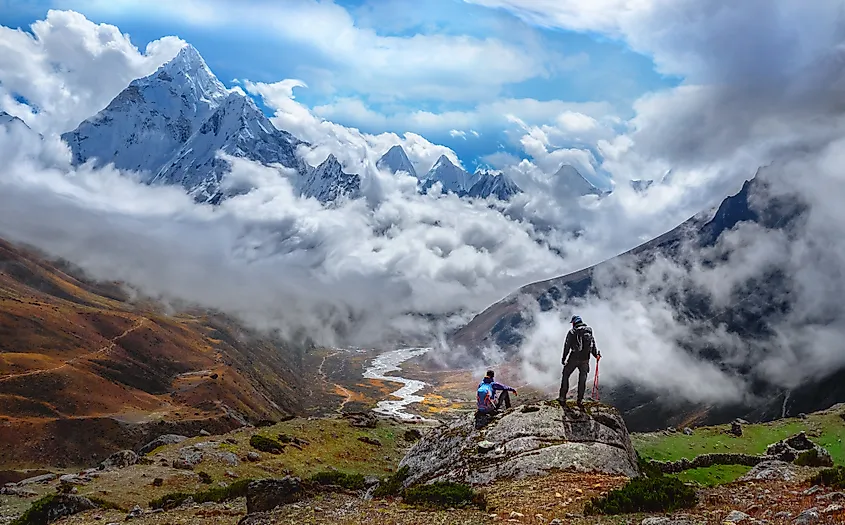Table of Contents
Everest Base Camp trekking is one of the most sought-after and iconic adventures for travelers and trekkers from all around the world. As the gateway to the world’s tallest mountain, Mount Everest, the trek offers not only a chance to stand at the foot of the mighty peak but also provides breathtaking views, cultural insights, and an unforgettable experience of the Himalayas. Whether you are an experienced hiker or a beginner, the Everest Base Camp (EBC) trek is a journey that will challenge your limits and reward you with life-changing memories.
Overview of the Trek
The Everest Base Camp trek takes trekkers through the stunning Khumbu region of Nepal, following a well-established route from Lukla to Everest Base Camp at an altitude of 5,364 meters (17,598 feet). The journey typically takes about 12 to 14 days, with several acclimatization stops along the way to adjust to the increasing altitude.
The trek begins with a scenic flight from Kathmandu to Lukla, a small mountain airstrip that is often regarded as one of the most dangerous airports in the world. From Lukla, trekkers start their journey on foot, passing through picturesque villages, dense forests, and rushing rivers. The path is dotted with Buddhist monasteries, prayer flags, and stupa sites, offering a rich cultural and spiritual experience.
Key Highlights of the Trek
- Breathtaking Views of Everest
The trek provides unrivaled views of Mount Everest and other neighboring peaks like Ama Dablam, Lhotse, and Nuptse. The Kala Patthar viewpoint, situated at an elevation of 5,545 meters (18,192 feet), offers the most stunning panoramic views of Everest, particularly during sunrise. - Sherpa Culture
Along the way, trekkers have the opportunity to interact with the Sherpa people, who are renowned for their mountaineering skills and hospitality. The Sherpas have a deep connection to the mountains and a rich Buddhist culture, which is reflected in the many monasteries and gompas you will encounter. The Tengboche Monastery, located at 3,860 meters, is one of the most significant spiritual sites on the route. - Unique Villages
Trekking through Sherpa villages like Namche Bazaar, Phakding, and Dingboche provides insight into the daily life of the local people. Namche Bazaar is the largest town on the route, a bustling hub for trade and supplies, and an important acclimatization stop.
The Challenge of Altitude
As you trek higher into the Khumbu region, the altitude begins to take its toll. At Everest Base Camp, the oxygen levels are significantly lower, and altitude sickness can become a serious concern. To help combat this, the trek includes several acclimatization days, particularly in Namche Bazaar and Dingboche.
It is essential to take these acclimatization days seriously and not rush the ascent. Proper hydration, adequate rest, and a gradual increase in elevation will help the body adjust. If altitude sickness symptoms, such as headaches, dizziness, and nausea, occur, it is important to descend to a lower altitude immediately.
Best Time to Trek
The best time to embark on Everest Base Camp trekking is during the spring (March to May) and autumn (September to November) seasons. These months offer clear skies, mild temperatures, and the best views of the Himalayas. The weather during these periods is relatively stable, with minimal rainfall, which makes for safer trekking conditions.
The summer monsoon (June to August) should be avoided due to the heavy rains, muddy trails, and potential landslides. Winter trekking is possible but is extremely cold, with temperatures often dropping below freezing, and many teahouses may be closed.
Accommodation and Food
Accommodation during the trek consists primarily of teahouses, which are simple lodges run by local families. The rooms are typically basic, with twin beds, blankets, and shared bathrooms. As you climb higher, the facilities become more basic, but the warmth and hospitality of the Sherpa people make up for the simplicity of the accommodations.
Meals along the trail are hearty and designed to provide trekkers with enough energy for the day’s hike. Typical meals include dal bhat (lentil soup with rice), noodles, fried rice, and Tibetan bread. Hot drinks such as tea, coffee, and lemon ginger tea are commonly available.
Permits and Logistics
To trek to Everest Base Camp, trekkers need to obtain a few permits:
- Sagarmatha National Park Permit
- Khumbu Pasang Lhamu Rural Municipality Permit
These permits are essential for entering the region and can be obtained in Kathmandu or through a licensed trekking agency.
Most trekkers choose to hire a guide and porter for assistance on the trek. Having a guide can enhance the experience by providing local insights, ensuring safety, and helping with navigation. A porter will carry your heavier gear, allowing you to focus on the trek itself.
Conclusion
Lukla Flight is an unforgettable journey to one of the most remote and awe-inspiring places on Earth. The trek offers more than just the chance to see the world’s highest mountain—it’s an adventure filled with breathtaking landscapes, rich cultural encounters, and personal growth. Whether you’re looking to challenge yourself physically, spiritually, or both, the journey to Everest Base Camp is sure to leave you with lasting memories and a deep appreciation for the Himalayas.

